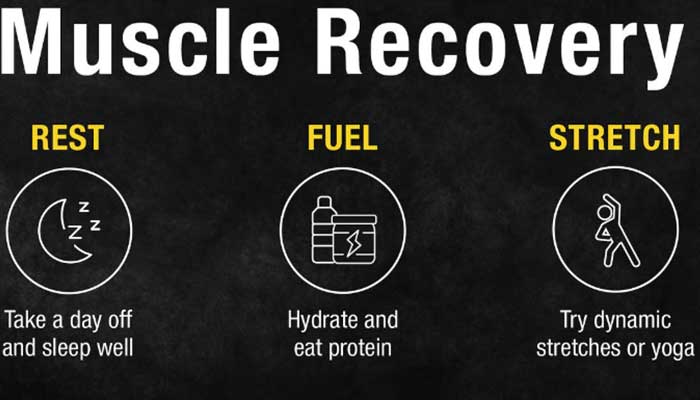
Muscle rehabilitation is not a luxury for athletes; it is an essential component of any training practice. Whether you’re a seasoned gym-goer, a weekend warrior, or recuperating from an injury, faster muscle recovery is critical for improving performance, avoiding injury, and reaching long-term goals. This guide explains the most effective and scientifically supported strategies for recovering your muscles rapidly and efficiently.
1. Prioritize Proper Nutrition
Muscle recovery starts with what you feed your body. Nutrients serve an important function in healing damaged muscle fibers and replenishing energy.
- Protein Is Not Negotiable
Muscle tissue is made up of proteins, and after an exercise, your muscles require amino acids to heal and expand. Aim for 20 – 40 grams of high-quality protein after a workout. Choose lean meats, eggs, dairy, whey protein, or plant-based options such as lentils, tofu, and quinoa.
- Carbohydrates Restore Energy
Your glycogen stores are reduced following vigorous physical exertion. Carbohydrates are required to replace glycogen that fuels your muscles for the exercise. For endurance activities, use a 3:1 or 4:1 carb-to-protein ratio.
- Hydration Is Power
Water facilitates all metabolic processes and nutrition transport. Dehydration has an immediate negative impact on recovery. Drink enough of water and try electrolyte-rich beverages after strenuous workouts.
- Anti-Inflammatory Foods Accelerate Healing
To naturally reduce inflammation, incorporate foods such as turmeric, berries, fatty salmon, ginger, and leafy greens.
2. Sleep – The Ultimate Anabolic Window
Sleep is the most underestimated restorative tool.
- Deep sleep promotes muscle regeneration through the production of growth hormone.
- Aim for 7 – 9 hours of unbroken sleep each night.
- Establish a sleep regimen with a dark room, cool temperature, and no screens before bedtime.
- If you are sleep-deprived, take brief naps (15 – 20 minutes). These mini-rests are neurologically beneficial.
3. Active Recovery
While complete rest has its benefits, active recuperation is often more beneficial.
- Low-impact movement promotes blood flow without straining muscles.
- Examples include brisk walking, low-intensity cycling, swimming, yoga, and mobility drills.
- Improves circulation and eliminates metabolic waste e.g. lactic acid.
- Eliminates stiffness and muscle tightness.
4. Strategic Supplementation
Supplements aren’t magic medicines but when utilized correctly, they can help with speedier muscle recovery.
- Use whey or plant-based protein powder for post-workout convenience.
- Creatine Monohydrate boosts strength and lowers recovery time.
- BCAAs (Branched Chain Amino Acids) are beneficial for fasting workouts.
- Omega-3 Fatty Acids have powerful anti-inflammatory properties.
- Magnesium promotes muscle relaxation and reduces cramping.
5. Contrast Therapy and Cold Exposure
Ice baths and contrast showers can help muscles heal faster and feel less sore.
- Cold Exposure
- Cold exposure e.g. ice baths, cryotherapy can reduce muscular inflammation.
- Reduces delayed-onset muscular soreness (DOMS).
- For optimal results, use within a few hours of intense training.
- Contrast Therapy
- Improves circulation and lymph drainage.
- For 4 – 5 cycles, alternate between heat (2 – 3 minutes) and cool (30 seconds to 1 minute).
6. Stretching and Mobility Work
Recovery is more than just recovering; it’s about getting ready for the next challenge.
- Static stretching is best done after a workout or on rest days.
- Holding for 20 – 60 seconds each muscle group promotes flexibility and lengthens tight, constricted muscles.
- Dynamic stretching is effective for warming up and maintaining range of motion during active recovery days.
- Use foam rollers or massage balls to release muscle adhesions and knots.
- After an exercise, focus on each muscle group for 1 – 2 minutes.
7. Professional Recovery Tools and Techniques
If you want to see real outcomes, invest in rehabilitation.
- Percussion massage guns promote blood flow and relieve muscle tension immediately.
- Normatec and other compression therapy devices improve circulation and lymphatic drainage.
- Physical therapy and sports massage can help with chronic discomfort and muscle imbalances.
8. Train Smart
Overtraining is the quickest way to poor performance and slow recovery.
- Respect your relaxation days. Muscles grow at rest not during workouts.
- Follow a periodized training schedule that includes light, moderate, and strenuous days.
- Listen to your body. Soreness is normal but persistent discomfort and exhaustion are red signals.
9. Mental Recovery and Stress Management
Mental stress affects your physical health. Chronic stress increases cortisol levels which can impede muscle recovery and disrupt sleep. You can follow the given actionable steps.
- Practice mindfulness through meditation, writing, and deep breathing.
- Avoid excessive caffeine and alcohol consumption.
- To keep your nervous system in check, engage in activities and spend time relaxing.
10. Monitor and Adjust
You can’t improve what you don’t track.
- Use a fitness notebook or app to track exercises, soreness, sleep quality, and mood.
- Adjust training volume according to recovery indicators.
- Consider employing wearables such as WHOOP or Oura Ring to gain detailed insights.
You can’t out-train bad recuperation. If you’re working hard in the gym but not seeing results or worse, regressing, it’s time to focus on recovery. The tactics outlined above are not optional; they are necessary components of a sustainable, high-performance lifestyle.
When you prioritize recovery alongside training, you create the foundation for improved performance, fewer injuries, and faster muscle growth. Your muscles are only as powerful as your recuperation abilities.

Leave a Reply